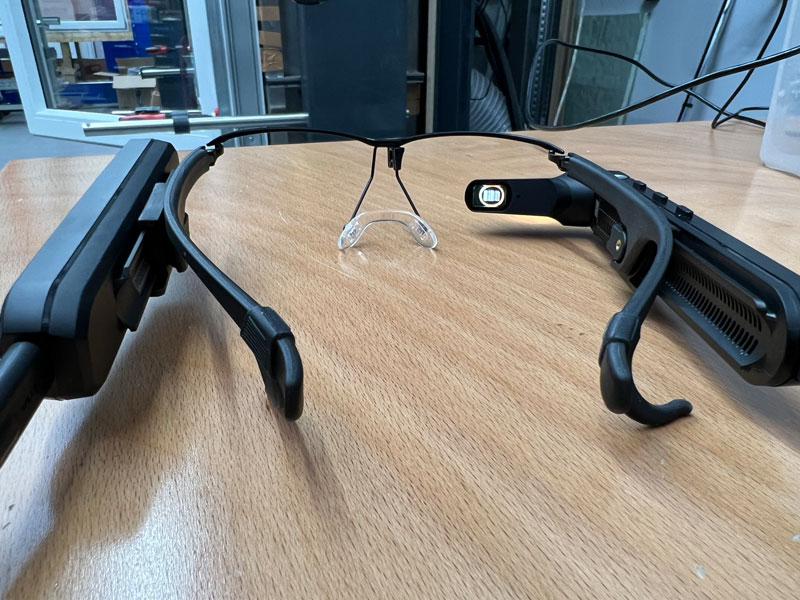We both spy with our little eyes

Smartglasses have been in use at GEALAN since mid-2021. They contain a camera that shows another person what is visible through the glasses in real time. The technology eliminates the need to travel long distances – to attend training courses and perform machine maintenance, for example – and enables instant assistance with urgent repairs.
As we all know, time is money. And where the smartglasses save time, no money is spent. ‘We are currently using three of these glasses in Oberkotzau and we’re testing them thoroughly’, says Kay Sommermann, Test Centre Department Head, of the unusual design. The goal, he says, is to equip each location in the group with one soon. An integrated camera transfers images, and there is a microphone for the sound. Both can be recorded. And the wearer also receives information thanks to a mini-monitor in the field of vision.
The smartglasses run on the Android operating system, which enables the installation of apps like Webex. Then, the smartglasses can be invited to join a meeting. All the other attendees can then see what the camera shows. The tiny monitor inside the glasses duplicates this image for the wearer. ‘That lets me control what the other people are seeing and adjust the frame if necessary,’ says Kay Sommermann, explaining how it all work. ‘The monitor image doesn’t bother me. It’s very clear when I focus on it but easy to block out when I concentrate on what’s happening in front of the glasses.’

That makes the smartglasses invaluable when, for instance, urgent repairs need to be made at a distant location. Or when there are problems that specialists from around the world can now be called on to help solve. Kay Sommermann offers some examples: ‘A colleague in Poland can use these glasses to look into a control cabinet full of wires and connections, and our expert here guides him through the necessary procedures step by step. Or with complex customer complaints, the customer takes us through the problem with images and sound and gets support for everything that needs to be done in real time. That saves long, expensive trips.’
A bit of advance planning is still required, since these glasses are not yet in use everywhere. It takes two to three days to send the glasses to customers, for example. That is far easier, not to mention cheaper, than sending the specialists themselves. Another requirement: a stable data connection. ‘The glasses film, transfer and record the data in very high resolution,’ Kay Sommermann says. ‘So you need Wi-Fi that works well.’
What are the optical and practical features of the GEALAN smartglasses? ‘We chose a model that doesn’t have lenses, so there’s no danger of breakage. Glasses with lenses are also not ideal in dusty areas. Since we sometimes use them on construction sites, we are better off with models that don’t have lenses.’ Additional benefits of the GEALAN models: The material is very stable, flexible and break-resistant. What’s more, the glasses can easily attach to protective goggles and construction hardhats.
Marc Schenk
11/08/2022
Recent news

Working for the future
Talking to GEALAN about sustainability is fun because nobody in this company is satisfied with simple answers. And because bright minds ask important questions, think about things carefully to seek good solutions, and then actually implement them. GEANOVA met with four of these clever people.

The revolution after the defeat
A sombre silence fills the car. A frustrated Ahmet Çak and his colleague Gyula Lélek have been driving on the Hungarian M1 motorway for about half an hour. The customer they had visited terminated their collaboration after hearing about a price increase. Çak just recently took over as Head of Sales for Hungary and negotiated new terms with all customers. Now, however, he has lost this one window manufacturer as a customer and suffered a defeat. The Annahegyi motorway restaurant at the MOL petrol station in Budapest serves a nice espresso so they exit the motorway. The frustration gives way to defiance over coffee and Çak motivates his colleague: ‘We’ve got to learn from this defeat!’ A ‘magic moment’ as he will later refer to it.

A strong bond
Neckties have been slung around the necks of men and women for centuries. It is a fashion accessory and style icon with its own holiday – International Necktie Day: on 18 October, the guards of honour in the Cravat Regiment ride through Zagreb and decorate statutes with cravats to send the message that neckties are Croatian. It’s even said that in the 17th century France’s King Louis XIV took a liking to the ‘à la manière croate’ (Croatian-style) cravats that Croatian mercenaries wore. The Sun King introduced the piece of uniform to Parisian society. The flagship store of Croata, a specialty shop for ties and scarves, is located in the Oktogon Passage in Zagreb’s city centre. GEANOVA met Klaudija Čota and Robert Križanović there. 18 years spent working together at GEALAN Croatia connects them, just like a tightly tied knot in a necktie.
Use our manufacturer locator.
Do not miss any news!
I want to receive newsletter "Reference Building of the Month" and GEALAN news via E-Mail (approx. twice a month) - free of charge and terminable at any time.